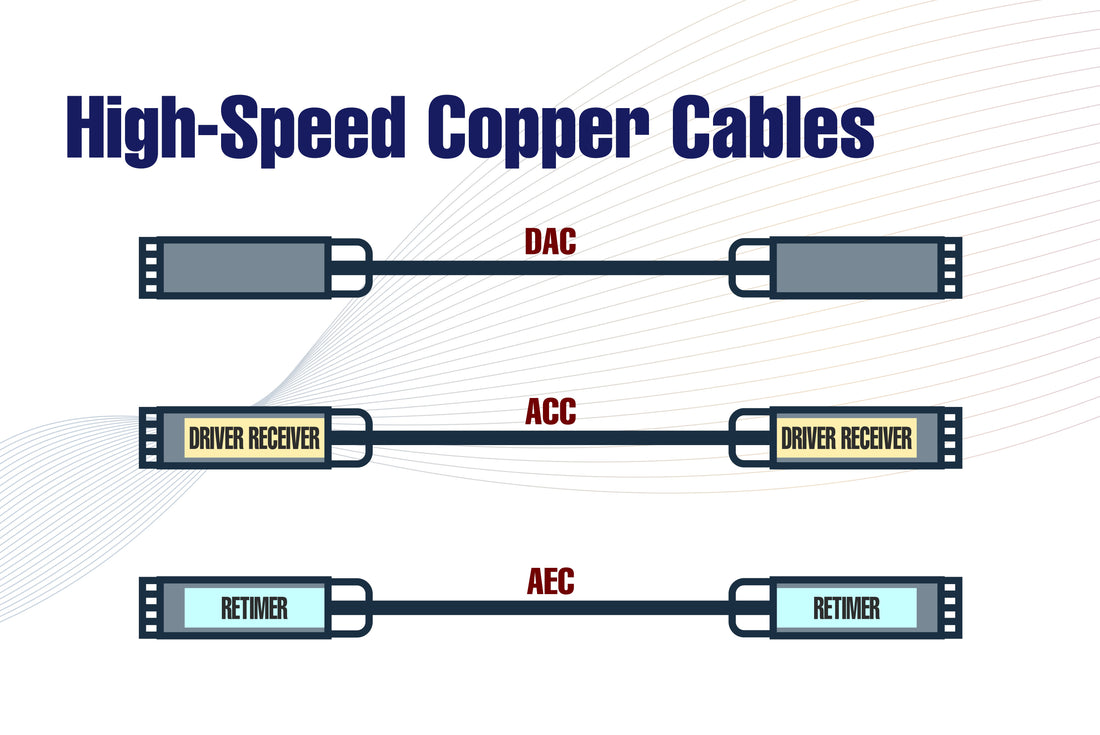
High-Speed Copper Interconnects for Modern Data Centers: A New Era with DAC, ACC, and AEC
OptechTWShare
High-Speed Copper Interconnects for Modern Data Centers: A New Era with DAC, ACC, and AEC
As hyperscale data centers and AI infrastructure scale rapidly, the need for low-latency, high-bandwidth, and cost-effective connectivity becomes more urgent. Among the most crucial components of intra-data center interconnects are high-speed copper cables, including:
-
DAC (Direct Attach Cable)
-
ACC (Active Copper Cable)
-
AEC (Active Electrical Cable)

These copper-based solutions address the needs of short- to medium-distance connections, offering a balance between signal performance, transmission distance, and power efficiency.
🔍 Overview: What Are DAC, ACC, and AEC?
| Type | Signal Integrity | Distance | Power | Cost | Flexibility |
|---|---|---|---|---|---|
| DAC | Low | ≤3m | 0W | 💲 Lowest | Rigid |
| ACC | Medium | 3–7m | <2W | 💲💲 Mid | Moderate |
| AEC | High | 5–15m+ | ~3W | 💲💲💲 High | High |
🧵 1. What is DAC (Direct Attach Cable)?
DAC is a passive copper cable that requires no external power or electronics. It's ideal for short-range, cost-sensitive applications within server racks.
-
Zero power consumption
-
Low latency (<0.1μs)
-
Ultra-low cost
-
Limitations: Only supports up to 3m, reduced reach at 800G speed
🧠 Best use case: Server-to-switch in-rack links for hyperscale deployments.
🔌 2. What is ACC (Active Copper Cable)?
ACC features a Redriver chip at the Rx end, which boosts signal quality and extends reach beyond DAC capabilities.
-
Signal equalization with CTLE and Driver
-
Lower attenuation
-
Power consumption: 1.2–1.8W
-
More flexible and longer reach than DAC
🧠 Best use case: Intra-rack connections or medium-distance switch/server links.
🔁 3. What is AEC (Active Electrical Cable)?
AEC integrates a Retimer chip at both ends, offering full signal regeneration and superior performance.
-
Advanced signal processing: CTLE, DFE, CDR, FIR drivers
-
Supports long distances (5–15m+)
-
Highest signal integrity
-
Ideal for dense cabling environments
🧠 Best use case: Cross-rack interconnects, AI data centers, and complex wiring.
📊 DAC vs. ACC vs. AEC: Comparison Diagram
Signal Integrity Distance Power Use Cost Flexibility
DAC ●○○○○ ≤3m ● ● ○
ACC ●●○○○ 3–7m ●● ●● ●
AEC ●●●●● 5–15m+ ●●● ●●● ●●●
📦 Use Case Recommendations
| Scenario | Recommended Cable |
|---|---|
| Server-to-ToR within same rack | DAC |
| Short cross-rack or chassis switch | ACC |
| Long reach, high-density networks | AEC |
| AI-driven data centers | AEC |
| Budget-sensitive deployments | DAC |
📈 Market Trends & Adoption Outlook
According to LightCounting, the global high-speed cable market will reach $6.7 billion by 2029, with AEC capturing the largest share due to AI-driven demand and advanced networking needs.
-
AEC is the fastest-growing due to longer reach and signal stability
-
DAC remains dominant for low-cost, short links
-
ACC bridges the gap with better reach at mid-range cost
✅ Choosing the Right Cable: A Strategic Decision
Select based on:
-
Distance requirements (≤3m → DAC, 3–7m → ACC, >7m → AEC)
-
Signal integrity needs
-
Power & thermal budgets
-
Rack density and cable routing complexity
🚀 Conclusion
High-speed copper cables—DAC, ACC, and AEC—each serve a unique purpose in building scalable, efficient, and high-performance data center networks.
-
DAC: Passive, simple, and cheap.
-
ACC: Balanced solution for distance and signal quality.
-
AEC: Best-in-class performance for complex, high-speed deployments.
The right choice enhances reliability, reduces cost, and prepares your infrastructure for next-generation AI and HPC workloads.
